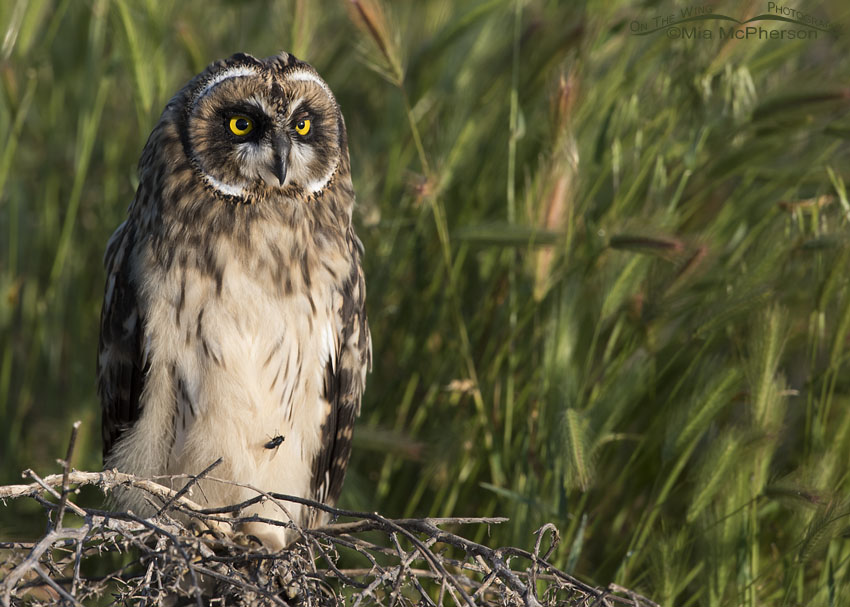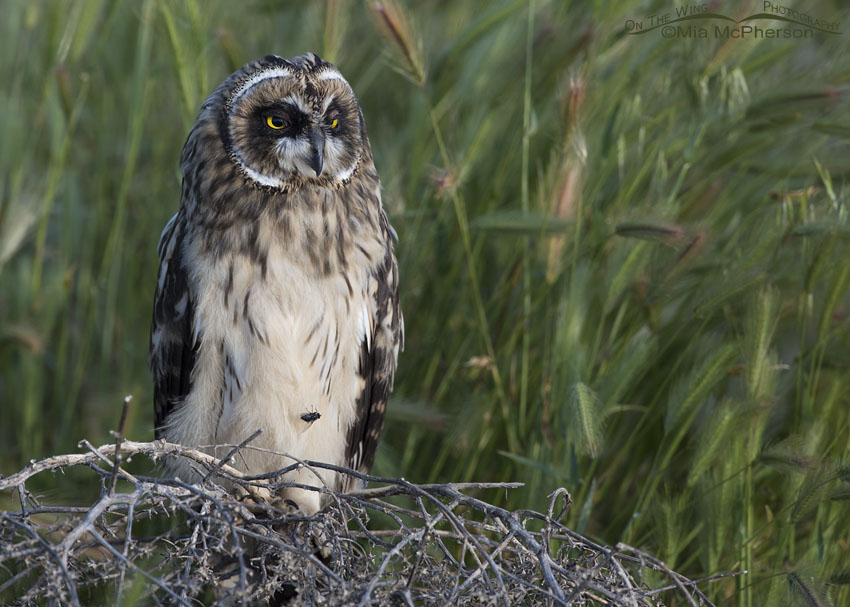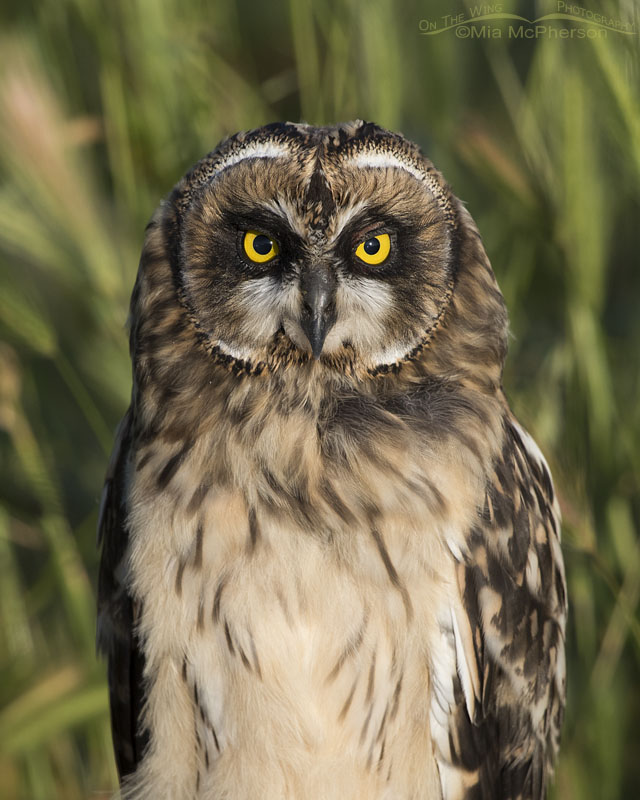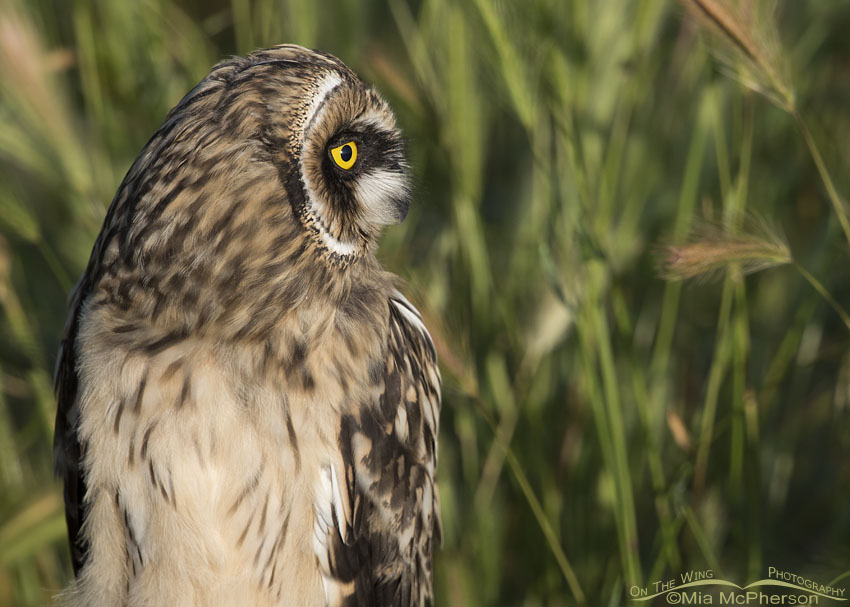 Short-eared Owl fledgling with a fly on its belly – Nikon D810, f7.1, 1/640, ISO 320, -0.3 EV, Nikkor 500mm VR with 1.4x TC, natural light, not baited
Short-eared Owl fledgling with a fly on its belly – Nikon D810, f7.1, 1/640, ISO 320, -0.3 EV, Nikkor 500mm VR with 1.4x TC, natural light, not baited
I was looking through my image archives yesterday and came across the series of images of two Short-eared Owl fledglings that I photographed on May 30, 2016 and decided to process a few more of the photos that I had taken that day. I had completely forgotten that I had meant to share this photo of one of the owl fledglings perched on a tumbleweed that showed a large fly on its belly both here on my blog and in my photo galleries.
The sun hadn’t been above the horizon for very long when I spotted this fledgling Short-eared Owl with its sibling next to a paved road in northern Utah. I photographed this fledgling first because it was more out in the open than the other chick and because I loved the tumbleweed perch, the fly didn’t seem to bother the young owl at all. The green grasses behind the owl glowed in the early morning light and they were just far enough away from the owl to be barely out of focus and complemented the warm tones of the owlet’s plumage.
 Cloud passing over a Short-eared Owl fledgling – Nikon D810, f7.1, 1/400, ISO 320, -0.3 EV, Nikkor 500mm VR with 1.4x TC, natural light, not baited
Cloud passing over a Short-eared Owl fledgling – Nikon D810, f7.1, 1/400, ISO 320, -0.3 EV, Nikkor 500mm VR with 1.4x TC, natural light, not baited
That warm glow disappeared briefly when a heavy cloud passed between the sun and the young Short-eared Owl and the images I took for those few seconds lost the golden tones and the photos I took during those few seconds were cooler in tone.
From inside the “mobile blind” I could see that the cloud was going to move quickly and that the warm glow would soon return and it did.
I photographed both of these two images in FX mode on my Nikon D810 with the 500mm VR lens and 1.4x teleconverter which means my effective focal length was 700mm. FX mode is using the entire sensor of the camera.
 Portrait of a fledgling Short-eared Owl head on – Nikon D810, f7.1, 1/1000, ISO 320, -1.0 EV, Nikkor 500mm VR with 1.4x TC, natural light, not baited
Portrait of a fledgling Short-eared Owl head on – Nikon D810, f7.1, 1/1000, ISO 320, -1.0 EV, Nikkor 500mm VR with 1.4x TC, natural light, not baited
While I photographed the fledgling Short-eared Owl I switched over to the DX mode on the D810 after a bit so I could take close ups of the young owl without moving any closer to it. I really like the ability to switch back and forth between the FX and DX modes on that camera body. Switching over to DX mode with the D810 combined with the 1.4x teleconverter on my 500mm VR lens gives me an effective focal length of 1050mm.
I liked how the young owl was facing me head on in this frame which gave me a great view of its large, bright yellow eyes. Note that there is a difference in pupil size, the eye getting the most sunlight shows the smaller pupil size, this is quite normal for owls.
 Side view of a Short-eared Owl fledgling – Nikon D810, f7.1, 1/1000, ISO 320, -1.0 EV, Nikkor 500mm VR with 1.4x TC, natural light, not baited
Side view of a Short-eared Owl fledgling – Nikon D810, f7.1, 1/1000, ISO 320, -1.0 EV, Nikkor 500mm VR with 1.4x TC, natural light, not baited
Both of the fledgling Short-eared Owls I took photos of that morning appeared very relaxed while I photographed them, they looked around, preened, yawned, stretched, and even rested with their eyes closed. I didn’t spend much time with these Short-eared Owl fledglings because I did not want to interfere with their lives or prevent the adults from bringing food to their young. It was a truly joy to photograph them, thank the owls and move on down the road that bright May morning.
Life is good.
Mia
Click here to see more of my Short-eared Owl photos plus facts and information about this species.





Wonderful pics Mia. Short eared owls are among my faves in the bird world. Thanks.
Incredible Mia, simply incredible. Wonderful studies of a beautiful bird. Thanks.
Beautiful, I hope they return, they are somewhat nomadic.
That third shot is so intense; I love the warm light on those beige feathers.
Beautiful pictures! Although the archive pictures always make me think that opportunities to get out aren’t that good. Hoping for blue skies. John
I love these images! And especially when s/he is giving you stink eye! I love stink eye, but that said, I also back up because I KNOW I’m edible! LOL!
What beautiful creatures they are!
Beautiful photos. I had to go back to look to see the difference in pupil size. I hadn’t even noticed that.
Exquisite. I love it.